You are wondering whether to choose between the Roomba 671 vs I3 products that suit your needs. The article below will examine the features and compare the two machines.
The Roomba i3 is the clear winner in this comparison. It has good cleaning performance and upgraded navigation capabilities. Plus, it offers high-performance filtering and a greater operating range, and the I3 rightfully claims the lead in this competition.
The Roomba 671 is a great choice if you’re looking for a reliable robot vacuum. It offers excellent cleaning performance and has some unique features of its own. If you’re on a tight budget, the 671 is a great choice.
Roomba 671 Vs I3: Comparison Chart




Roomba 671 Vs I3: Differences
The Roomba i3 clearly prevailed in this showdown with the Roomba 671, with a final score of 3-0 to a 1-all draw. Explore the key differences between these two remarkable robot vacuum cleaners.
Cleaning performance
The winner: Roomba I3
Hardwood floor
When comparing the performance of the Roomba 671 vs i3 on hardwood floors, the i3 is the clear winner in terms of efficiency. The i3 utilizes advanced floor tracking sensors to navigate in straight, neat rows, ensuring a more logical and purposeful cleaning experience. In contrast, the 671 moves randomly, which can sometimes result in missed spots or redundant cleaning.
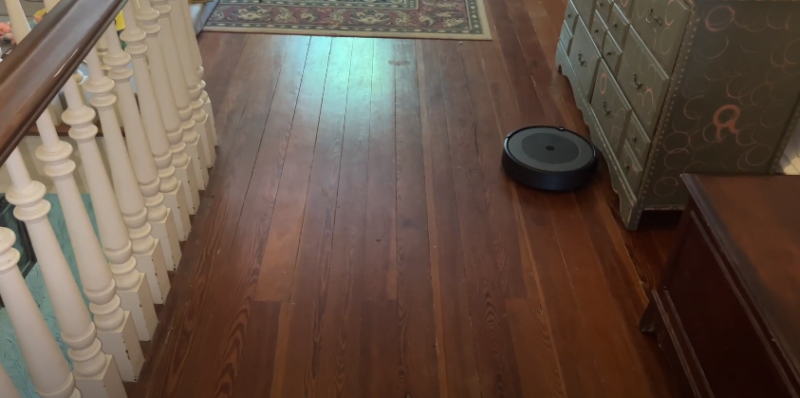
Both robot vacuums have powerful, fast-spinning side brushes that effectively clean edges and remove debris and dust. However, they also tend to scatter larger debris on hard floors, which can actually prolong the cleaning process. While both models are capable of picking up small, light items like rice, crumbs, and cereal, they struggle with larger debris, which is a limitation to keep in mind.
Carpets
| Roomba I3 | Roomba 671 | |
|---|---|---|
| Low-pile Carpet | ≈ 95% | ≈ 91% |
| High-pile Carpet | ≈ 89% | ≈ 85% |
Both the Roomba i3 and the Roomba 671 perform best on low-pile carpets, moving seamlessly across the surface and picking up large amounts of dirt and debris. However, they both struggle with smaller particles, like sand. On medium-pile carpets, the i3 demonstrates superior suction efficiency, removing approximately 89% of dirt, while its performance is even better on low-pile carpets, with a 95% efficiency rate.
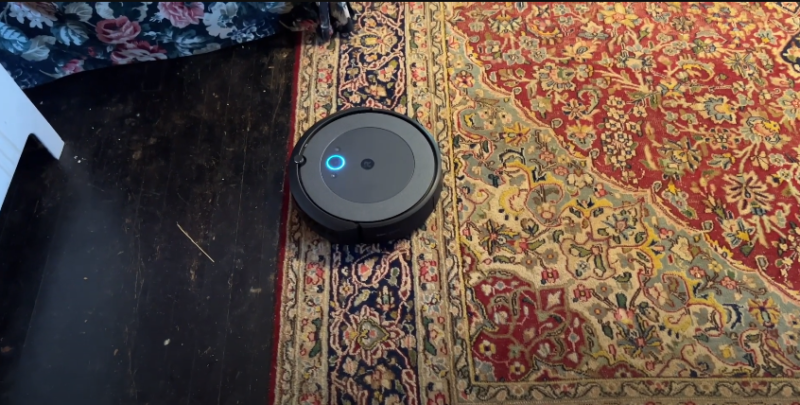
While the 671 performs relatively well, its overall performance is slightly lower than that of the i3. Despite this, the 671 still stands out as one of the better options available in its price range. One of the standout features of the i3 is its ability to seamlessly transition from hard floors to carpets, as well as its inclusion of a cliff sensor, which helps prevent the vacuum from falling down stairs.
Hair test
The Roomba i3 takes the lead over the Roomba 671, proving to be more effective and efficient in picking up pet hair while minimizing tangling. The i3’s superiority in handling pet hair can be attributed to its advanced brush roll system architecture, which features two rubberized brush rolls. These squeegee rolls are adept at lifting larger debris and finer particles, such as pet hair and dust, from various floor types while simultaneously preventing tangles.
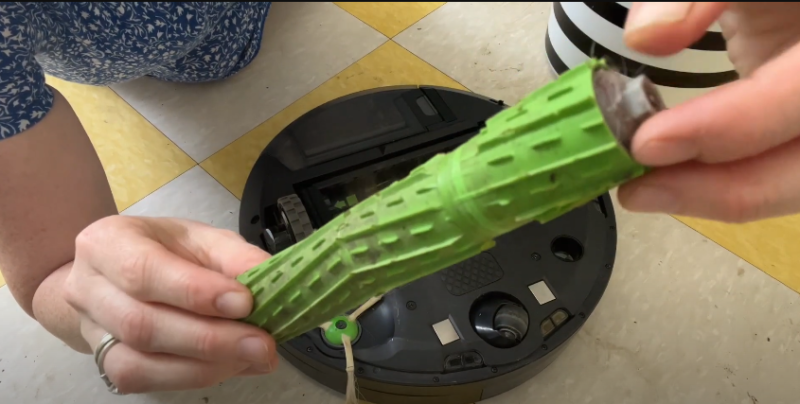
In comparison, the Roomba 671 is equipped with a bristle brush and a feather duster. While the bristle brush is effective at dislodging dirt and debris from carpets, it may not be as proficient at capturing pet hair as the i3’s upgraded brush system. Therefore, for pet owners or those dealing with significant amounts of hair, the Roomba i3 is the recommended choice.
Design and Usability
The winner: Roomba I3
Dimensions & Weight
The dimensions and weight of the Roomba 671 vs I3 are fairly comparable, both featuring a compact and low-profile design that is conducive to cleaning in tight spaces and convenient for storage. The Roomba i3 has a diameter of 13.26 inches, a height of 3.63 inches, and weighs 7.44 pounds. On the other hand, the Roomba 671 has similar dimensions but is slightly heavier, weighing approximately 7.8 pounds.
These machines’ compact size and low profile are significant advantages, as they can easily navigate under furniture and other tight spaces where dirt and dust tend to accumulate, all while taking up minimal storage space when not in use. In this category, the difference in weight is minimal and is unlikely to significantly impact your choice between the two models.
Navigation
The Roomba i3 is significantly superior to the Roomba 671. The 671 relies on stochastic response navigation, utilizing sensors to detect obstacles and dirt as it moves around the home. While this method can be effective in smaller rooms, it tends to be less efficient in larger areas and may miss spots, especially around wooden furniture. It’s also worth noting that the 671 must collide with walls and objects to change direction, which can result in a fair amount of noise.
In contrast, the Roomba i3 is equipped with advanced vSLAM and iAdapt 2.0 navigation technology, which greatly enhances its ability to map out and navigate cleaning areas. The top-mounted camera of the i3 allows it to create a visual map of the area, helping it to recognize furniture and other obstacles and subsequently clean in straight, efficient rows. This technology gives the i3 a clear edge in terms of navigation and overall cleaning efficiency.
Battery
Both the Roomba 671 vs I3 are equipped with lithium-ion batteries known for their high energy density and long life. However, there is a notable difference in their battery life. The Roomba i3 offers up to 75 minutes of cleaning time on a full charge, whereas the Roomba 671 surpasses that with a runtime of up to 90 minutes.
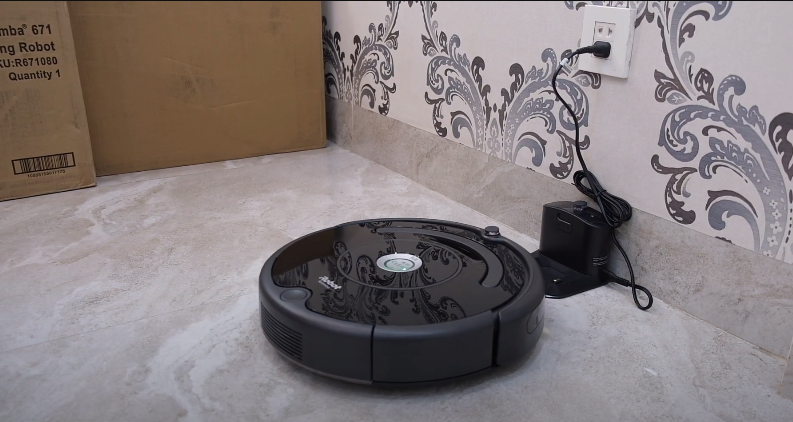
However, the disparity in battery life is not a significant concern, as both robots feature self-recharging capabilities. This means that when the battery starts running low, the vacuum will return to its docking station to recharge and resume cleaning from where it left off. This feature ensures that your cleaning task is not left incomplete due to a depleted battery.
Additionally, both the Roomba 671 vs I3 have a battery indicator, which makes it easy to monitor the battery status and know when it’s time to recharge. This feature is particularly useful when you are managing the vacuum through a smartphone application, as it allows you to keep track of the cleaning progress and battery life from anywhere.
Control
Tie!
Both the Roomba 671 vs i3 feature physical controls on the device itself, which allow for easy manual control of the vacuum’s various functions, such as spot cleaning, power, and docking. Moreover, both robots can be controlled remotely through the iRobot application via a Wi-Fi network. This application is incredibly user-friendly and offers several valuable features, such as scheduling cleaning sessions, viewing cleaning history, receiving battery level notifications, and remotely navigating the robot. You can even set the vacuum to clean while you’re away from home.
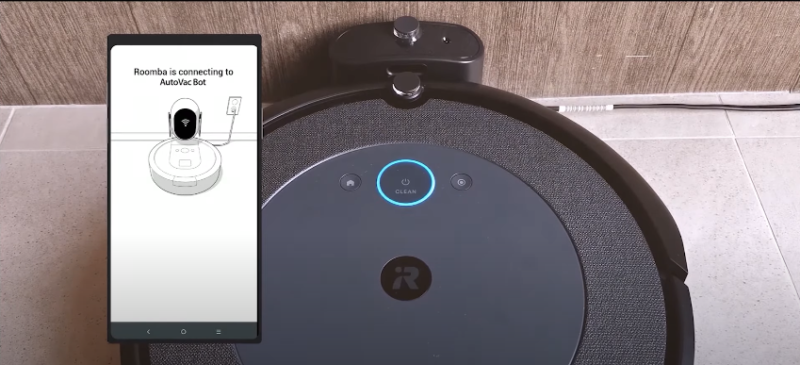
An additional advantage of these devices is their compatibility with home assistants like Amazon Alexa and Google Assistant. This compatibility enables users to control the vacuum with voice commands, making it convenient to start or stop a cleaning session without having to lift a finger. The integration of these features and functionalities in both the Roomba 671 vs i3 ensures a convenient and hassle-free cleaning experience for users.
Cleaning & Maintenance
The winner: Roomba I3
Both the Roomba 671 vs i3 have comparable cleaning and maintenance requirements. They have been designed with user convenience in mind, featuring brush rollers and castor wheels that are simple to disassemble for regular cleaning and inspection.
However, there are some differences between the two models when it comes to dustbin capacity and filtration systems. The Roomba 671 has a relatively small dustbin with a capacity of approximately 0.3 liters, while the i3 has a slightly larger bin capable of holding up to 0.4 liters of debris. For those with pets, especially those with long fur, the larger dustbin of the i3 may be preferable, as it won’t fill up as quickly, resulting in less frequent emptying.
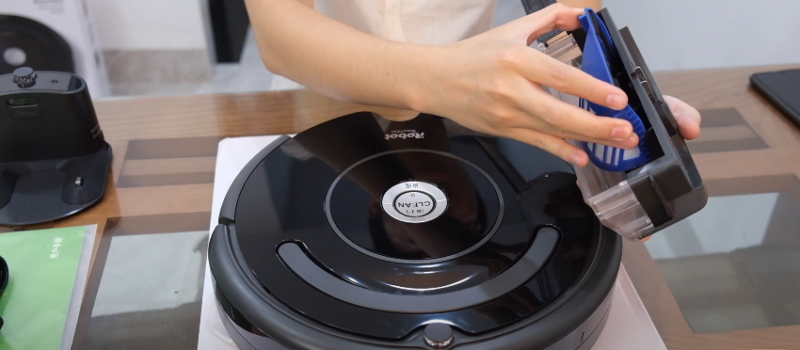
Regarding filtration, the Roomba i3 has a slight edge as it utilizes a highly effective HEPA filter to capture microscopic dust particles and allergens. This makes the i3 a great option for pet owners and individuals with allergies or asthma. In contrast, the Roomba 671 uses a standard filter, which is less effective at trapping finer particles.
Quick Rundown Of Roomba I3:
- POWERFUL CLEANING—SCHEDULED AROUND YOUR LIFE - Whether you’re relaxing at home or out enjoying life, Roomba i3 EVO takes care of dirt and messes with a Premium 3-Stage Cleaning System and 10x the Power-Lifting Suction*. *Compared to Roomba 600 series.Runtime : 75 minutes
- CLEAN BY ROOM, YOU’RE IN CONTROL - Roomba i3 EVO learns your home and creates an Imprint Smart Map so you can direct it to clean any room you want, any time you want—either on a set schedule or in the moment.
- CLEANING IN TIDY ROWS - Cleans intelligently in straight lines back and forth, to thoroughly clean your floors while navigating around furniture. When the i3 EVO needs to recharge, it will resume right where it left off ensuring a complete clean. Charger : 120V and 60 Hz
- FOCUSED CLEANING - Patented Dirt Detect Technology allows the Roomba i3 EVO to detect dirtier areas of your home and clean them more thoroughly. Integrated sensors tell the robot where it can and can’t fit, so it doesn’t get stuck under furniture.
- PERFECT FOR HOMES WITH PETS - Instead of using a single bristle brush, Roomba i3 EVO uses Dual Multi-Surface Rubber Brushes that flex to adjust to different floor types and avoid getting tangled with pet hair.
Quick Rundown Of Roomba 671:
- CLEAN SMARTER - The 600 series is a great way to begin cleaning your home smarter. Just schedule it to clean up daily dirt, dust, and debris with the iRobot HOME app or your voice assistant. - for effortlessly clean floors.
- LOOSENS, LIFTS, and SUCTIONS - The 3 Stage Cleaning system and Dual Multi-Surface brushes grab dirt from carpets and hard floors, an Edge-Sweeping brush takes care of corners and edges.
- LEARNS YOUR LIFE LISTENS TO YOUR VOICE - Learns your cleaning habits to offer up personalized schedules, while Google Assistant and Alexa allow you to start cleaning with just the sound of your voice. The 671 will even suggest an extra clean when your area’s pollen count is high or during pet shedding season. *Works with Google Home and Alexa enabled devices Alexa and all related logos are trademarks of Amazon.com or its affiliates. Google is a trademark of Google LLC
- ADAPTIVE NAVIGATION - A full suite of advanced sensors allow Roomba to navigate under and around furniture, and along edges. Cliff Detect keeps it from falling down stairs.
- SENSES AND ELIMINATES DIRT - Dirt Detect Sensors alert your robot about dirtier areas of your home, like high-traffic spots, and cleans them more thoroughly.
Product Videos
Related Articles to Roomba I3
- iRobot Roomba I3 Vs S9+: A Detailed iRobot Vacuum Comparison
- Roomba 692 vs i3: A Head-To-Head Comparison
- Roborock Q5 vs Roomba I3: Clean Homes Powerhouse Face-Off!
- Roomba 981 Vs I3: How Do You Choose The Best Option For Your Home?
- Roomba 698 vs i3: Best Picks for Your Home!
- Roomba i3 vs j7: A Clash of Premium vs. Entry-Level Models
- Roomba i3 vs i7: Which Robot Vacuum Is Right For You?
- Roomba i3 vs i4: Which Affordable Entry-Level Roomba Is the Better Choice?
- Neato D8 vs Roomba i3: Which Robot Vacuum Is Right For You?
- Roomba i3 vs 960: Which iRobot Roomba Is The Most Affordable Option?
- Eufy G30 vs Roomba i3: Which Is The Better Option For Your Home?
References:
- Roomba I3: https://irobotmy.com/product/roomba-i3-robot-vacuum/
- Roomba 671: https://www.irobot.com/en_US/roomba-vacuuming/robot-vacuum-irobot-roomba-671/R671020.html

Richard B. Schmidt is a prominent figure in the vacuum cleaner industry, boasting over 15 years of expertise. Armed with a Robotics Engineering degree from Northeastern University and a Master’s in Consumer Science from Harvard, his unique blend of technical knowledge and consumer insights positions him as a sought-after authority in vacuum cleaner evaluation. Richard’s career began at Dyson, where he contributed to the development of innovative vacuum models. Transitioning to advocacy and reviews, he co-founded the first Vacuum-focused blog in 2008, offering comprehensive analysis and user guides for various vacuum cleaners. In 2020, he founded RoboMop.net, providing ongoing insights through columns and buyer’s guides.
